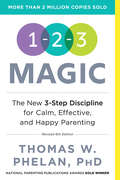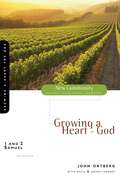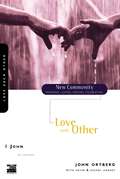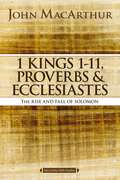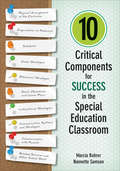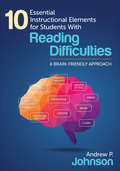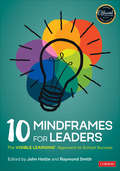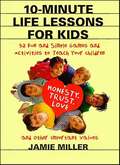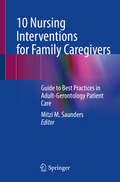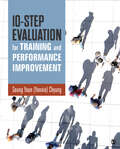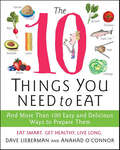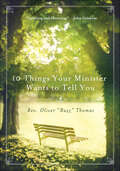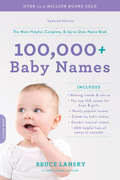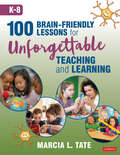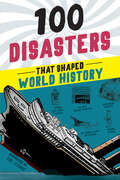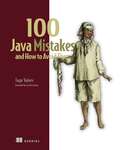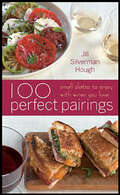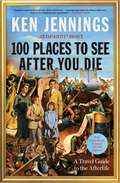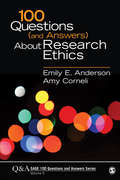- Table View
- List View
1-2-3 Magic: 3-Step Discipline for Calm, Effective, and Happy Parenting
by Thomas Phelan PhD"Everywhere you go, you keep overhearing other moms say to their misbehaving children, 'That's one. That's two. That's three.' And then you watch in disbelief as their kid actually stops!"—PopSugar MomsThe most effective parenting guide for tantrums.Do you want to strengthen your parent-child bond? What about learning how to build self-esteem early on in your toddler, preschooler, or middle schooler? Are you ready to have a calm, happy family and home? This therapist-recommended, evidence-based book is the #1 resource for effective and enjoyable parenting using gentle techniques that work.Since kids don't come with a manual, 1-2-3 Magic is the next best thing. Using his signature counting method, Dr. Thomas Phelan helps parents to quickly, calmly, and effectively stop obnoxious behaviors like tantrums and meltdowns, whining and pouting, talking back, sibling rivalry, and more by teaching your child how to regulate their emotions in a way that's safe for them and drama-free for you.You'll also learn how to:Build a solid foundation for being a confident parentManage testing and manipulation to avoid derailing your effortsEncourage good behaviorStrengthen your relationship with your childEstablish positive bedtime, dinnertime, homework, and wake-up routinesMillions of parents from all over the world have used this bestselling child discipline book to raise happier families and put the fun back into parenting—and you can too!1-2-3 Magic is one of Healthline's Best Parenting Books of 2017, a 2016 Mom's Choice Award Winner, a 2016 National Parenting Product Award Winner and a 2016 Family Choice Award Winner.
1 and 2 Samuel: Growing a Heart for God (New Community Bible Study Series)
by John OrtbergWritten by the dynamic leaders of church ministry across the country, this series explores life-changing topics from a biblical perspective. New Community guides don&’t force small groups to choose between Bible study and building community. Just the opposite. Each study delves deeply into Scripture in a way that strengthens relationships. Challenging questions encourage group members to reflect not only on Scripture but also on their own lives—individually and as a part of God&’s family. And unlike most Bible studies, the New Community series helps study groups convert biblical principles into practical teamwork—helping at the soup kitchen, bringing a meal to someone, writing an encouraging letter, and so on. Filled with prayer, insight, intimacy, and action, each study in this series will help group members line up their lives and relationship more closely with the Bible&’s model for the church.
1 John: Love Each Other (New Community Bible Study Series)
by John Ortberg Kevin & HarneyWhen God pours out his love, our parched lives are revived and our thirsty souls satisfied. What is the secret of receiving more of God's love and of giving it freely to others? The book of I John calls us back to the basics of loving God and one another. Do you long to experience God's mercy and goodness in deeper ways and extend them to others? Would you like his love to fill you up to the point where it overflows naturally into the lives of others? This study of I John will help you and your small group experience the refreshing rain of God's love in ways you have always wanted. New Community Series -- a high-impact tool for experiencing the transforming power of God's Word. This cutting-edge series lets you explore life-changing topics from a biblical perspective in community with others in your small group. Challenging questions encourage you to reflect on Scripture and its impact on your life, both as an individual and as part of a community of Christ followers.
1 Kings 1 to 11, Proverbs, and Ecclesiastes: The Rise and Fall of Solomon (MacArthur Bible Studies)
by John F. MacArthurSolomon is known as the wisest man who ever lived. His writings in the Old Testament range from practical, pithy proverbs to beautiful romantic poetry—and all are filled with his knowledge and insights. Yet behind those writings stood a flawed man who was conflicted between deep wisdom and tragic folly. Sadly, the king who warned against so many sins did not follow his own advice, and he wound up leading Israel into idolatry. Nevertheless, his life and writings provide valuable lessons for us today in the twenty-first century.In this study, pastor John MacArthur will guide you through an in-depth look at the historical period beginning with Solomon's ascent to the throne and continuing through his tragic end. Studies include close-up examinations of the vital importance of wisdom—with portraits of the wise woman, the foolish sluggard, and others in the book of Proverbs—and careful considerations of doctrinal themes such as "True Wisdom from God" and "A Time for Everything."—ABOUT THE SERIES—The MacArthur Bible Study series is designed to help you study the Word of God with guidance from widely respected pastor and author John MacArthur. Each guide provides intriguing examinations of the whole of Scripture by examining its parts and incorporates:Extensive, but straight-forward commentary on the text.Detailed observations on overriding themes, timelines, history, and context.Word and phrase studies to help you unlock the broader meaning and apply it to your life.Probing, interactive questions with plenty of space to write down your response and thoughts.
10 Critical Components for Success in the Special Education Classroom: Gargiulo: Special Education In A Contemporary Society 5e + Rohrer: 10 Critical Components For Success In The Special Education Classroom
by Marcia W. Rohrer Nannette M. SamsonYour blueprint for building structure, consistency, and accountability year-round! Often teachers of all experience levels struggle to effectively manage special education classrooms. In this must-have guide, Rohrer and Sampson provide a solid, workable action plan to ensure measurable success for even your most challenging student. Discover a variety of research-based instructional strategies to: Support all students, including those with autism and severe learning disabilities Organize your classroom, materials, and staff and student schedules for optimal teaching and learning Execute well-planned standards-based lessons, annual IEP’s, PLAALP’s, behavioral interventions, and visual supports Develop communication and social skills within a language-rich environment Foster parent communication and staff collaboration Packed with real-world examples, free tools to use and share, a list of resources and a helpful glossary, this dynamic resource will inspire you, develop your teacher toolbox, and ensure your students are on the path to achievement! "10 Critical Components for Success in the Special Education Classroom offers practical and easy-to-use ideas for organizing your physical classroom space, materials, student and staff schedules. Readers will also receive well thought out strategies that will definitely aid in the ultimate end result—student success!" —Avis Canty, Special Education Teacher Tanglewood Middle School, Greenville, SC "The path to success for students with autism and intellectual disabilities starts here, when their teachers implement the essential critical components outlined in this book." —Renee Bernhardt, Learning Support for Special Education and RTI Cherokee County School District, Canton, GA
10 Critical Components for Success in the Special Education Classroom: Gargiulo: Special Education In A Contemporary Society 5e + Rohrer: 10 Critical Components For Success In The Special Education Classroom
by Marcia W. Rohrer Nannette M. SamsonYour blueprint for building structure, consistency, and accountability year-round! Often teachers of all experience levels struggle to effectively manage special education classrooms. In this must-have guide, Rohrer and Sampson provide a solid, workable action plan to ensure measurable success for even your most challenging student. Discover a variety of research-based instructional strategies to: Support all students, including those with autism and severe learning disabilities Organize your classroom, materials, and staff and student schedules for optimal teaching and learning Execute well-planned standards-based lessons, annual IEP’s, PLAALP’s, behavioral interventions, and visual supports Develop communication and social skills within a language-rich environment Foster parent communication and staff collaboration Packed with real-world examples, free tools to use and share, a list of resources and a helpful glossary, this dynamic resource will inspire you, develop your teacher toolbox, and ensure your students are on the path to achievement! "10 Critical Components for Success in the Special Education Classroom offers practical and easy-to-use ideas for organizing your physical classroom space, materials, student and staff schedules. Readers will also receive well thought out strategies that will definitely aid in the ultimate end result—student success!" —Avis Canty, Special Education Teacher Tanglewood Middle School, Greenville, SC "The path to success for students with autism and intellectual disabilities starts here, when their teachers implement the essential critical components outlined in this book." —Renee Bernhardt, Learning Support for Special Education and RTI Cherokee County School District, Canton, GA
10 Essential Instructional Elements for Students With Reading Difficulties: A Brain-Friendly Approach
by Andrew P. JohnsonBrain-friendly strategies to help all students become lifelong readers Learning to read is more than just an educational issue; it’s a social justice issue. Did you know that struggling readers are twice as likely as their peers to drop out of high school? Through time-tested, research-based neurocognitive teaching strategies, 10 Essential Instructional Elements for Students with Reading Difficulties will enable you to hone readers’ skills and help students from all grade levels develop their ability to create meaning from print. Drawing from five key areas of neurocognitive research, Andrew Johnson provides a ten-point teaching strategy that encompasses vocabulary, fluency, comprehension, writing and more. A key resource for creating intervention plans for struggling readers, features include: Information on the often-overlooked importance of emotions in the process of overcoming reading struggles Strategies to promote voluntary reading, even for the most reluctant students Useful resources such as graphic organizers, additional reading and writing activities, and QR codes that link to videos Use these strategies today and you can count on more students leaving your classrooms as fluent, lifelong readers. "Dr. Johnson tells the story of reading in a logical and clear manner with a book that is excellently researched, immaculately referenced, and full of practical tips for the practitioner." Terry Bernstein, Former Senior Literacy Difficulties Specialist London Boroughs of Camden and Westminster, UK "This is the text I wish I had when I began to teach. Dr. Johnson clearly illustrates the process our brain uses to create meaning from text." Marty Duncan, Ed.D., Author and Former Educator
10 Essential Instructional Elements for Students With Reading Difficulties: A Brain-Friendly Approach
by Andrew P. JohnsonBrain-friendly strategies to help all students become lifelong readers Learning to read is more than just an educational issue; it’s a social justice issue. Did you know that struggling readers are twice as likely as their peers to drop out of high school? Through time-tested, research-based neurocognitive teaching strategies, 10 Essential Instructional Elements for Students with Reading Difficulties will enable you to hone readers’ skills and help students from all grade levels develop their ability to create meaning from print. Drawing from five key areas of neurocognitive research, Andrew Johnson provides a ten-point teaching strategy that encompasses vocabulary, fluency, comprehension, writing and more. A key resource for creating intervention plans for struggling readers, features include: Information on the often-overlooked importance of emotions in the process of overcoming reading struggles Strategies to promote voluntary reading, even for the most reluctant students Useful resources such as graphic organizers, additional reading and writing activities, and QR codes that link to videos Use these strategies today and you can count on more students leaving your classrooms as fluent, lifelong readers. "Dr. Johnson tells the story of reading in a logical and clear manner with a book that is excellently researched, immaculately referenced, and full of practical tips for the practitioner." Terry Bernstein, Former Senior Literacy Difficulties Specialist London Boroughs of Camden and Westminster, UK "This is the text I wish I had when I began to teach. Dr. Johnson clearly illustrates the process our brain uses to create meaning from text." Marty Duncan, Ed.D., Author and Former Educator
10 Mindframes for Leaders: The Visible Learning Approach to School Success
by Raymond Smith John HattieIt’s not what you do, it’s how you think about what you do. Mindframes—your internal set of beliefs about your role as school leader—determine the high-impact leadership practices you choose to implement. In other words, how you think about the impact of the actions you take has more effect on student achievement than your leadership practices themselves. Building on over twenty-five years of Visible Learning research and girded by a theory of action that ensures school leaders have the expertise to select, implement, and evaluate high impact interventions, 10 Mindframes for Leaders: The VISIBLE LEARNING® Approach to School Success brings the mindframes of ten world-renowned educators to life. Ten chapters, each written by a different thought leader, detail a mindframe at the heart of successful school leadership, along with the high probability influences that make each mindframe visible. A must-have resource for any educator working toward student achievement at ever-higher levels, each chapter includes: • The most current, up-to-date findings from the Visible Learning research, including the factors from Visible Learning that support each mindframe • Practical ideas for leaders to implement high-impact strategies in classrooms and schools • Vignettes, questions, insights, and exercises to help educators clarify and refine their own mindframes Lead your school to reform from the inside out. Cultivate these ways of thinking, and you’re more likely to have major impacts on the learning lives of those students entrusted to your care. Includes Contributions From…John Hattie, Peter DeWitt, Raymond L. Smith, Doug Fisher, Janet Clinton, Nancy Frey, Dylan Wiliam, Dominique Smith, Jenni Donohoo, Laura Link, Michael Fullan, Sugata Mitra, Zaretta Hammond, Jim Knight
10 Mindframes for Leaders: The Visible Learning Approach to School Success
by Raymond Smith John HattieIt’s not what you do, it’s how you think about what you do. Mindframes—your internal set of beliefs about your role as school leader—determine the high-impact leadership practices you choose to implement. In other words, how you think about the impact of the actions you take has more effect on student achievement than your leadership practices themselves. Building on over twenty-five years of Visible Learning research and girded by a theory of action that ensures school leaders have the expertise to select, implement, and evaluate high impact interventions, 10 Mindframes for Leaders: The VISIBLE LEARNING® Approach to School Success brings the mindframes of ten world-renowned educators to life. Ten chapters, each written by a different thought leader, detail a mindframe at the heart of successful school leadership, along with the high probability influences that make each mindframe visible. A must-have resource for any educator working toward student achievement at ever-higher levels, each chapter includes: • The most current, up-to-date findings from the Visible Learning research, including the factors from Visible Learning that support each mindframe • Practical ideas for leaders to implement high-impact strategies in classrooms and schools • Vignettes, questions, insights, and exercises to help educators clarify and refine their own mindframes Lead your school to reform from the inside out. Cultivate these ways of thinking, and you’re more likely to have major impacts on the learning lives of those students entrusted to your care. Includes Contributions From…John Hattie, Peter DeWitt, Raymond L. Smith, Doug Fisher, Janet Clinton, Nancy Frey, Dylan Wiliam, Dominique Smith, Jenni Donohoo, Laura Link, Michael Fullan, Sugata Mitra, Zaretta Hammond, Jim Knight
10-Minute Life Lessons for Kids: 52 Fun and Simple Games and Activities to Teach Your Children Honesty, Trust, Love, and Other Important Values
by Jamie C. Miller52 playful and easy to understand activites to hhelp parents teach children moral lessons that they won't forget A child says, "I hear and I forget, I see and I remember, I do and I understand." 10-Minute Life Lessons for Kids is a book about seeing and doing--a book that gives parents the ability to teach the powerful principles of honesty, trust, generosity, love, and other values. Children will discover the objectives themselves as they actively participate in fun games and activities. The games can be done in any order, with very little planning and with very few supplies--just common objects most people have around the house like toothpicks, string, pennies, or an apple. Some can be done while riding in the car, and others can be expanded to fill a whole evening with family fun. The activities in 10-Minute Life Lessons for Kids will not only create cozy and enjoyable moments of family togetherness, they will have a lasting impact on your growing child.
10 Nursing Interventions for Family Caregivers: Guide to Best Practices in Adult-Gerontology Patient Care
by Mitzi M. SaundersThis book shines a light on the family caregiver, who cares for their loved one when nurses are not involved. It guides nurses to identify and partner with family caregivers and infuses confidence and desire to support them. The unique feature of this book is to provide nurses with the ability to see themselves in the role of supporting the family caregiver in their own practices with older people. Written in story form with teachable moments interjected within, it develops on the struggles and needs of the family caregiver. This book draws the nurse closer to the family caregiver using empathy, compassion, and competency; it elaborates on best practices to support key interventions that every professional nurse can do. Narrowing to 10 key nursing interventions helps establish the scope of family caregiver nursing care. Much of family caregiver care stems from compassion and “being with” and supporting the patient through difficult times. This is both an art and a skill. This much needed book guides nurses towards the family caregiver, the silent patient.
10-Step Evaluation for Training and Performance Improvement
by Seung Youn ChyungWritten with a learning-by-doing approach in mind, 10-Step Evaluation for Training and Performance Improvement gives students actionable instruction for identifying, planning, and implementing a client-based program evaluation. The book introduces readers to multiple evaluation frameworks and uses problem-based learning to guide them through a 10-step evaluation process. As students read the chapters, they produce specific deliverables that culminate in a completed evaluation project.
10-Step Evaluation for Training and Performance Improvement
by Seung Youn ChyungWritten with a learning-by-doing approach in mind, 10-Step Evaluation for Training and Performance Improvement gives students actionable instruction for identifying, planning, and implementing a client-based program evaluation. The book introduces readers to multiple evaluation frameworks and uses problem-based learning to guide them through a 10-step evaluation process. As students read the chapters, they produce specific deliverables that culminate in a completed evaluation project.
The 10 Things You Need to Eat: And More Than 100 Easy and Delicious Ways to Prepare Them
by Anahad O'Connor Dave LiebermanNew York Times health columnist Anahad O’Connor teams up Food Network chef Dave Lieberman for The 10 Things You Need to Eat—a hip, straightforward, and appealing guide for understanding and incorporating the 10 most healthy foods into your diet, with more than 100 easy and delicious ways to prepare them. A fun and unintimidating approach to Super Foods—filled with mouth-watering, user-friendly recipes—The 10 Things You Need to Eat is ideal for foodies and non-foodies alike who want to be healthier, look better, and live longer without having to sacrifice when it comes to taste.
10 Things Your Minister Wants to Tell You: (but Can't, Because He Needs The Job)
by Oliver "Buzz" ThomasA well-known minister speaks from the heart to all those centrist Christians looking for a way to worship God in today's world"How did it all begin?" "What happens when we die?" These are just two of the questions Reverend Oliver "Buzz" Thomas hears centrist Christians asking as he travels across the U.S. and he knows that their voices are not being heard. They're people of faith, not of politics, and they want more from their religion than a voter's guide. In 10 Things Your Minister Wants to Tell You (But Can't Because He Needs the Job), Rev. Thomas has written a book that will become the liberal Christian answer to The Purpose Driven Life. He writes sensitively about the reason we were put on this earth, the significance of the Bible and how one pleases God. He answers difficult, contemporary questions like "What about homosexuality?" and "What about other faiths?". Rev. Thomas weaves a Christian theology for today that people will embrace as a guide to sensible, modern living.
100,000+ Baby Names: The most helpful, complete, & up-to-date name book
by Bruce LanskyThe most helpful, complete, and yearly up-to-date name book What's new about names? The new edition of 100,000+ Baby Names by Bruce Lansky features the most up-to-date lists of names, trends, advice, and fascinating facts about names, including:Hundreds of newly popular names and variationsThe latest list of top 100 names for boys and girlsThe latest naming trends: what's hot and what's notThe most rapidly rising and falling top 1,000 namesUpdated lists of names to consider, including names of newly famous people and fictional charactersThe most popular gender-neutral names and their rates of use (more for boys, more for girls, or 50/50)New (and classic) celebrity baby names And our list of names from around the world keeps growing! Here you'll find more than 100,000 names--complete with origins, meanings, variations, and famous namesakes. You'll find names from major linguistic and ethnic groups of origin, including English (19,000 names), Latin (11,000 names), Greek (11,000 names), American (11,000 names), Hebrew (9,000 names), Hispanic (9,000 names), French (8,000 names), Irish (7,000 names), and German (6,000 names)--plus thousands of Scottish, Welsh, Italian, Russian, Japanese, Chinese, Scandinavian, Polish, Native American, Hawaiian, Korean, Thai, Vietnamese, Australian/Aboriginal, African, and Hindi names. The list features unique spellings of popular names that are catching on, plus newly popular names and variations not listed in other books and websites.
100 Brain-Friendly Lessons for Unforgettable Teaching and Learning (K-8)
by Marcia L. TateUse research- and brain-based teaching to engage students and maximize learning Lessons should be memorable and engaging. When they are, student achievement increases, behavior problems decrease, and teaching and learning are fun! In 100 Brain-Friendly Lessons for Unforgettable Teaching and Learning K-8, best-selling author and renowned educator and consultant Marcia Tate takes her bestselling Worksheets Don’t Grow Dendrites one step further by providing teachers with ready-to-use lesson plans that take advantage of the way that students really learn. Readers will find 100 cross-curricular sample lessons from each of the four major content areas: English/language arts, mathematics, science, and social studies. Plans designed around the most frequently taught objectives found in national and international curricula. Lessons educators can immediately replicate in their own classrooms or use to develop their own. 20 brain-compatible, research-based instructional strategies that work for all learners. Five questions that teachers should ask and answer when planning brain-compatible lessons and an in-depth explanation of each of the questions. Guidance on building relationships with students that enable them to learn at optimal levels. It is a wonderful time to be a teacher! This hands-on resource will show you how to use what we know about educational neuroscience to transform your classroom into a place where success if accessible for all.
100 Brain-Friendly Lessons for Unforgettable Teaching and Learning (K-8)
by Marcia L. TateUse research- and brain-based teaching to engage students and maximize learning Lessons should be memorable and engaging. When they are, student achievement increases, behavior problems decrease, and teaching and learning are fun! In 100 Brain-Friendly Lessons for Unforgettable Teaching and Learning K-8, best-selling author and renowned educator and consultant Marcia Tate takes her bestselling Worksheets Don’t Grow Dendrites one step further by providing teachers with ready-to-use lesson plans that take advantage of the way that students really learn. Readers will find 100 cross-curricular sample lessons from each of the four major content areas: English/language arts, mathematics, science, and social studies. Plans designed around the most frequently taught objectives found in national and international curricula. Lessons educators can immediately replicate in their own classrooms or use to develop their own. 20 brain-compatible, research-based instructional strategies that work for all learners. Five questions that teachers should ask and answer when planning brain-compatible lessons and an in-depth explanation of each of the questions. Guidance on building relationships with students that enable them to learn at optimal levels. It is a wonderful time to be a teacher! This hands-on resource will show you how to use what we know about educational neuroscience to transform your classroom into a place where success if accessible for all.
100 Disasters That Shaped World History (100 Series)
by Joanne MatternAction-packed true stories of the biggest disasters in history - perfect for fans of the I Survived seriesDiscover how hurricanes, earthquakes, crashes, and other catastrophes have shaped world history! 100 Disasters That Shaped World History introduces kids of all ages to some of the most significant events in recorded history, from the Great Fire of London to the Challenger Disaster. This history book for kids features100 easy-to-read true disaster stories: Find out how catastrophes have changed the course of history!Illustrated images: Each page includes an illustration to help bring history to life!A timeline, trivia questions, project ideas, and more: Boost your learning and test your knowledge with fun activities and resources!Engaging and packed with facts, 100 Disasters That Shaped World History is the perfect history gift for curious kids 8 and up!
100 Java Mistakes and How to Avoid Them
by Tagir ValeevDodge the common mistakes that even senior developers make, take full advantage of static analysis tools, and deliver robust and error-free Java code.Whenever you make a mistake writing Java, it&’s almost guaranteed that someone else has made it before! In 100 Java Mistakes and How To Avoid Them you&’ll learn about the common and the not-so-common antipatterns, errors, and tricky bits that trip up almost every Java developer. Inside 100 Java Mistakes and How To Avoid Them you will learn how to: Write better Java programs Recognize common mistakes during programming Create fewer bugs and save time for debugging and testing Get help from static analyzers during programming Configure static analysis tools to reduce the number of false reports Extend static analysis tools with custom plugins Each Java mistake in this handy guide comes with an illustrative code sample, an explanation of why the mistake occurs, and an actionable &“ways to avoid this&” section to help you dodge the error. Plus, you&’ll benefit from useful static analysis sidebars that let you know when mistakes will—and won&’t—be spotted by static analysis tools. Foreword by Cay Horstmann. About the technology Minor bugs in development can become major problems in production. It&’s much better to spot and fix your mistakes before they get that far! This one-of-a-kind book shines a light on the most common Java slip-ups and shows you exactly how to avoid making them in the first place. About the book 100 Java Mistakes and How To Avoid Them highlights 100 Java coding errors—from beginner missteps to mistakes even Java experts don&’t know they&’re making. Each case includes clear examples to show you what to look for and concrete troubleshooting advice. You&’ll learn to use static analysis tools like IntelliJ IDEA and SonarLint to ensure you&’re consistently delivering exceptional Java, discover how unit tests and defensive coding can keep your code clean, and even learn to write your own bug-busting plugins. What's inside Recognize bugs and antipatterns during programming Highly-effective debugging and testing Get help from static analyzers About the reader For Java developers of all skill levels. About the author Tagir Valeev is a technical lead in JetBrains and a Java Champion. He designed and developed many code inspections for IntelliJ IDEA built-in static analyzer. The technical editor on this book was Jean-François Morin. Table of Contents 1 Managing code quality 2 Expressions 3 Program structure 4 Numbers 5 Common exceptions 6 Strings 7 Comparing objects 8 Collections and maps 9 Library methods 10 Unit testing A Static analysis annotations B Extending static analysis tools
100 Perfect Pairings: Small Plates to Enjoy with Wines You Love
by Jill Silverman HoughThe ideal pairing guide for wines of every kind100 Perfect Pairings shows you how to spice up your anytime gatherings with delicious, creative small plates that make perfect companions your favorite wines. For anyone who ever wished that they had more options to go with their Chardonnay or Merlot than just a cube of cheese, this book presents 100 cosmopolitan, yet accessible recipes that put typical finger foods to shame. From food writer and recipe developer Jill Silverman Hough, this book is packed with enticing appetizer options like Green Apple Caesar Salad and Peppercorn-Crusted Tuna. Organized by common wine varietals and illustrated with 40 lush color photos, 100 Perfect Pairings makes it a snap to match the perfect appetizer with your favorite wine. Includes 100 sophisticated and satisfying recipes without fancy jargon or hard-to-find ingredients Packaged in a small format that makes it perfect for gifts and for taking with you when you shop for food and wine Offers pairings for perennial favorites like Chardonnay and Merlot, as well as lesser-known varietals like Voignier and GewurtztraminerWhether pairing with a white, a rose, or a red, 100 enticing recipes offer exciting alternatives to the run-of-the-mill cheese plate.
100 Places to See After You Die: A Travel Guide to the Afterlife
by Ken JenningsFrom New York Times bestselling author and legendary Jeopardy! host and champion Ken Jennings comes a hilarious travel guide to the afterlife, exploring to die for destinations from literature, mythology, and pop culture.Ever wonder which circles of Dante&’s Inferno have the nicest accommodations? Where&’s the best place to grab a bite to eat in the ancient Egyptian underworld? How does one dress like a local in the heavenly palace of Hinduism&’s Lord Vishnu, or avoid the flesh-eating river serpents in the Klingon afterlife? What hidden treasures can be found off the beaten path in Hades, Valhalla, or TV&’s The Good Place? Find answers to all those questions and more about the world(s) to come in this eternally entertaining book from Ken Jennings. Written in the style of iconic bestselling travel guides, Jennings wryly outlines journeys through the afterlife, as dreamed up over 5,000 years of human history by our greatest prophets, poets, mystics, artists, and TV showrunners. This comprehensive index of 100 different afterlife destinations was meticulously researched from sources ranging from the Epic of Gilgamesh to modern-day pop songs, video games, and Simpsons episodes. Get ready for whatever post-mortal destiny awaits you, whether it&’s an astral plane, a Hieronymus Bosch hellscape, or the baseball diamond from Field of Dreams. Fascinating, funny, and irreverent, this &“gung-ho travel guide to Heaven, Hell, and beyond&” (The New Yorker) will help you create your very own bucket list—for after you&’ve kicked the bucket.
100 Questions (SAGE 100 Questions and Answers #5)
by Emily E. Anderson Amy L. Corneli100 Questions (and Answers) About Research Ethics is an essential guide for graduate students and researchers in the social and behavioral sciences. It identifies ethical issues that individuals must consider when planning research studies as well as provides guidance on how to address ethical issues that might arise during research implementation. Questions such as assessing risks, to protecting privacy and vulnerable populations, obtaining informed consent, using technology including social media, negotiating the IRB process, and handling data ethically are covered. Acting as a resource for students developing their thesis and dissertation proposals and for junior faculty designing research, this book reflects the latest U.S. federal research regulations to take effect mostly in January 2018.
100 Questions (SAGE 100 Questions and Answers #5)
by Emily E. Anderson Amy L. Corneli100 Questions (and Answers) About Research Ethics is an essential guide for graduate students and researchers in the social and behavioral sciences. It identifies ethical issues that individuals must consider when planning research studies as well as provides guidance on how to address ethical issues that might arise during research implementation. Questions such as assessing risks, to protecting privacy and vulnerable populations, obtaining informed consent, using technology including social media, negotiating the IRB process, and handling data ethically are covered. Acting as a resource for students developing their thesis and dissertation proposals and for junior faculty designing research, this book reflects the latest U.S. federal research regulations to take effect mostly in January 2018.
